Are you ready to embark on a culinary adventure that combines the essence of pandan leaves with the lightness of chiffon cake? Get ready, because we’re about to dive into the delightful world of Pandan Chiffon Cake! This recipe is a masterpiece that brings together the vibrant green hue and unique aroma of pandan leaves with the airy, melt-in-your-mouth texture of a classic chiffon cake. If you’re a baking enthusiast looking to impress your taste buds and your guests, this recipe is your golden ticket.
[ez-toc]
History
The story behind the Pandan Chiffon Cake is a journey that intertwines cultural influences, culinary innovation, and a touch of creativity. This iconic dessert has captured the hearts of many, offering a harmonious blend of flavors and textures that have stood the test of time.
Early Roots and Cultural Fusion
The roots of the Pandan Chiffon Cake can be traced back to the Southeast Asian region, where pandan leaves have been used for centuries to infuse dishes with their distinct aroma and flavor. The vibrant green hue of the leaves made them a natural choice for enhancing both the visual and sensory aspects of culinary creations.
As pandan leaves became a staple ingredient in traditional Southeast Asian cuisine, it was only a matter of time before they found their way into baked goods. Chiffon cake, a creation of the early 20th century, was already gaining popularity in Western baking circles for its airy and tender crumb. This lightweight cake seemed like the perfect canvas to showcase the essence of pandan leaves.
Innovation and Fusion in the Kitchen
The fusion of cultures and flavors led to a moment of culinary brilliance when pandan leaves met chiffon cake. The result was a cake that married the lightness of chiffon with the fragrance of pandan, creating a dessert that was both familiar and exotic. This fusion appealed to taste buds across continents and became a symbol of culinary creativity.
In the mid-20th century, as global communication and travel expanded, the Pandan Chiffon Cake transcended borders. Home bakers and professional chefs alike experimented with the recipe, adding their own twists and adaptations. The cake became a canvas for innovation, welcoming variations that ranged from coconut-infused layers to tropical fruit garnishes.
Cultural Symbolism and Celebration
The Pandan Chiffon Cake isn’t just a dessert; it’s a symbol of celebration and togetherness. In many Southeast Asian cultures, the cake is a staple at festive gatherings, weddings, and special occasions. Its vibrant green color and delicate flavor make it a representation of joy, prosperity, and new beginnings.
As the cake’s popularity continued to soar, it earned its place not only on dessert tables but also in the hearts of those who cherished its unique blend of flavors. Families passed down their cherished recipes, and bakers around the world continued to experiment with innovative ways to elevate the cake’s taste and presentation.
Modern Interpretations and Culinary Artistry
In the present day, the Pandan Chiffon Cake continues to captivate both home bakers and professional pastry chefs. It has found its way into cookbooks, food blogs, and cooking shows, where its history and flavors are celebrated. Modern variations include gluten-free versions, vegan adaptations, and even fusion twists that combine pandan with other global ingredients.
The cake’s journey from its humble beginnings to its present-day status as a beloved dessert is a testament to the power of culinary fusion, cultural exchange, and the enduring appeal of a perfectly baked confection. It’s not just a recipe; it’s a slice of history that has been shaped by the hands and palates of generations past and present.
So, the next time you savor a slice of Pandan Chiffon Cake, take a moment to appreciate the rich history and cultural tapestry that brought this delightful dessert to your plate. It’s a testament to the magic that can happen when ingredients, techniques, and traditions from different corners of the world come together in perfect harmony.
Time
| Step | Time |
|---|---|
| Preparing the Pandan-infused Mixture | 20 minutes |
| Mastering the Meringue | 15 minutes |
| Combining and Baking to Perfection | 45-50 minutes |
| Letting the Cake Cool Down | 1 hour |
| Slicing and Presentation | 10 minutes |
| Adding a Tropical Twist (Optional) | 10 minutes |
| Customizing Toppings and Fillings (Optional) | 15 minutes |
| Total Time | Approx. 2.5 to 3 hours |
Please note that these times are approximate and can vary based on individual cooking speed and experience.
Ingredients
| Ingredients | Quantity |
|---|---|
| Fresh pandan leaves or pandan extract | 2-3 leaves or 2 tsp |
| Eggs (both yolks and whites) | 2 large |
| Sugar (granulated and caster) | 1/4 cup each |
| Vegetable oil (neutral in flavor) | 1/4 cup |
| Cake flour | 1/2 cup |
| Baking powder | 1/2 tsp |
| Salt | Pinch |
| Coconut milk | 1/4 cup |
This quantity of ingredients is perfect for a smaller serving size, allowing you to enjoy a delightful Pandan Chiffon Cake without any leftovers.
Directions
Preparing the Pandan-infused Mixture
- Extract the Pandan Goodness:
- If using fresh pandan leaves, wash and chop 2-3 leaves into small pieces.
- Blend the chopped leaves with 1/4 cup of water until you get a smooth green mixture.
- Strain the mixture to obtain the pandan extract. If using pandan extract, skip this step.
- Whisk the Yolks:
- In a mixing bowl, whisk together the pandan extract (or pandan extract), egg yolks, 1/4 cup of caster sugar, and 1/4 cup of neutral vegetable oil until the mixture is well combined and slightly thickened.
- Incorporate the Flour:
- Gradually fold in 1/2 cup of cake flour, 1/2 teaspoon of baking powder, and a pinch of salt into the egg yolk mixture. Alternate with adding 1/4 cup of coconut milk in batches.
- Mix gently until the batter is smooth and no lumps remain.
Mastering the Meringue
- Beat Egg Whites:
- In a separate clean and dry bowl, beat 2 egg whites until they become foamy and frothy.
- Adding Sugar and Whipping:
- Gradually add 1/4 cup of granulated sugar while continuing to beat the egg whites.
- Beat the egg whites and sugar mixture until glossy peaks form. The meringue should be firm but not overwhipped.
- Combining the Mixtures:
- Gently fold the prepared meringue into the pandan-infused mixture in batches.
- Use a spatula to fold the mixtures together with a gentle, circular motion until no streaks of meringue remain. Be careful not to overmix and deflate the batter.
Combining and Baking to Perfection
- Preheat and Prep:
- Preheat your oven to the recommended temperature stated in the recipe.
- Grease the cake pan with a thin layer of oil or non-stick spray.
- Pouring the Batter:
- Pour the chiffon cake batter into the prepared cake pan, gently tapping the pan on the counter to release any air bubbles.
- Baking Away:
- Place the cake pan in the preheated oven and bake for the specified time, or until the cake is golden brown and a toothpick inserted into the center comes out clean.
Serving and Enjoyment
- Letting the Cake Cool Down:
- Once the cake is done baking, remove it from the oven and carefully invert the pan onto a wire rack.
- Allow the cake to cool completely in the pan. This helps the cake maintain its structure and prevents it from collapsing.
- Slicing and Presentation:
- Once the cake has cooled, gently run a knife around the edges of the pan to loosen the cake.
- Invert the pan again and transfer the cake onto a serving plate.
- Use a serrated knife to slice the cake into individual portions.
- Dust the slices with powdered sugar or serve with a dollop of whipped cream for an extra touch of indulgence.
Customization and Variations
- Adding a Tropical Twist (Optional):
- If desired, add a layer of coconut cream between the cake layers for added richness and flavor.
- Top the cake with toasted coconut flakes to enhance the tropical experience.
- Playing with Toppings and Fillings (Optional):
- Experiment with various toppings such as fresh fruit compotes, citrus glazes, or chocolate drizzles to personalize your Pandan Chiffon Cake.
With these detailed directions, you’ll be well on your way to creating a delightful and aromatic Pandan Chiffon Cake that’s sure to impress and satisfy your taste buds!
Equipment Required
Nutrition Information
| Nutrition Information | Per Serving |
|---|---|
| Serving Size | 1 slice |
| Calories | 150 kcal |
| Total Fat | 7g |
| – Saturated Fat | 2g |
| Cholesterol | 35mg |
| Sodium | 150mg |
| Total Carbohydrates | 20g |
| – Dietary Fiber | 0g |
| – Sugars | 12g |
| Protein | 3g |
Please note that these values are approximate and can vary based on factors such as the exact quantities of ingredients used and variations in portion sizes.
Tips
- Egg Separation Technique: When separating egg yolks from whites, ensure there’s no trace of yolk in the whites. Even a small amount of yolk can prevent proper egg white whipping.
- Folding Technique: When folding the meringue into the pandan mixture, use a gentle and deliberate folding motion to maintain the airiness of the batter. A rubber spatula is ideal for this.
- Pandan Extract Variability: The intensity of pandan extract can vary, affecting the color and flavor of your cake. Adjust the quantity of extract to achieve your desired level of pandan aroma.
- Cake Flour Sifting: Sift the cake flour and baking powder before incorporating them into the mixture. This helps prevent lumps and ensures an even distribution.
- Gentle Mixing: Avoid overmixing the batter. Overmixing can lead to a dense cake instead of the desired light and fluffy texture.
Pros & Cons
| Pros | Cons |
|---|---|
| ✅ Light and Fluffy Texture | ❌ Requires Precise Folding Technique |
| ✅ Unique Aroma and Flavor | ❌ Longer Preparation Time |
| ✅ Customizable with Various Toppings | ❌ Potential for Sinking Center |
| ✅ Beautiful Presentation | ❌ Requires Special Cake Pan |
| ✅ Fusion of Cultural and Culinary Delights | ❌ Contains Sugar and Saturated Fat |
Conclusion
In the world of baking, few creations boast the charm and elegance of the Pandan Chiffon Cake. With its ethereal texture, captivating aroma, and unique blend of flavors, this dessert promises a delightful culinary journey that’s well worth embarking upon. From the moment you infuse the pandan extract to the final slice that graces your plate, every step is an invitation to indulge in a slice of perfection.
As you dive into the art of creating this masterpiece, you’re not just following a recipe; you’re embracing a tradition that marries cultures, celebrates creativity, and transforms simple ingredients into a symphony of taste and aroma. While the process might require a little patience and precision, the reward is an exquisite cake that’s sure to captivate your taste buds and elevate your baking repertoire.
So, whether you’re a seasoned baker or a kitchen novice, don’t hesitate to give the Pandan Chiffon Cake a try. Let the vibrant green hue and alluring scent of pandan leaves transport you to a realm of culinary wonder. With every bite, you’ll be savoring a story that’s been shaped by generations of passionate cooks and creative minds. Go ahead, mix, fold, and bake your way to a slice of dessert perfection that’s as unforgettable as it is delicious. Your taste buds will thank you, and your kitchen will resonate with the aroma of sweet success. Happy baking! 🍰🌿
Facts
- Fact 1: A Fragrant Journey Through History 🌿
- Did you know that pandan leaves have been used for their aroma in Southeast Asian cuisine for centuries? These leaves, often referred to as the “vanilla of Asia,” found their way into chiffon cakes to create the iconic Pandan Chiffon Cake we adore today. It’s like taking a bite out of history and culture!
- Fact 2: The Meringue Magic 🥚
- Whipping up that perfect meringue isn’t just for show – it’s the secret to the cake’s heavenly lightness. Think of it as a magic potion that transforms humble egg whites and sugar into those pillowy peaks that make every slice of Pandan Chiffon Cake pure joy.
- Fact 3: The Cake that Defies Gravity 🎈
- Ever wonder how chiffon cakes manage to rise so high without collapsing? It’s all thanks to the unique tube pan they’re baked in. This ingenious design lets the cake cling to the sides as it bakes, creating that gravity-defying rise that’s a hallmark of chiffon cakes.
- Fact 4: Chiffon Cake’s Culinary Globe-Trotting ✈️
- What’s a cake that transcends cultures? The Pandan Chiffon Cake! Born from the marriage of Western chiffon cake techniques and Asian pandan leaves, it’s a true global citizen. This cake knows no borders – just the pure joy of delightful fusion.
- Fact 5: From Harry Baker to Your Kitchen 🍰
- The pioneer behind chiffon cakes, Harry Baker, didn’t just bake a cake; he created a legacy. His innovative chiffon cake recipe laid the foundation for masterpieces like the Pandan Chiffon Cake we relish today. Every slice is a nod to his baking brilliance!
FAQ’s
Can I use pandan extract instead of fresh leaves?
Absolutely! Pandan extract is a convenient substitute. Use 2 teaspoons of pandan extract for the recipe’s aromatic and flavorful touch.
Why did my cake turn out slightly dry?
A slightly dry cake could be due to overbaking. Keep a close eye on the baking time, as oven temperatures may vary. Perform the toothpick test – if it comes out with a few moist crumbs, your cake is perfectly baked.
How do I store leftover Pandan Chiffon Cake?
To maintain freshness, store the cake in an airtight container at room temperature for up to 2 days. For longer storage, refrigerate it, ensuring it’s covered to prevent drying.
Can I make cupcakes using this recipe?
Certainly! Adapt the recipe by using cupcake liners and reducing the baking time. Bake for about 15-20 minutes or until cupcakes spring back when touched.
What’s the origin of chiffon cakes?
Chiffon cakes were invented in the 1920s by Harry Baker, a California-based baker. His innovative recipe combined elements of sponge and angel food cakes, resulting in the airy and tender texture characteristic of chiffon cakes.
Can I reduce the sugar content without affecting the cake’s texture?
While reducing sugar can slightly alter texture and taste, you can experiment with a moderate reduction. Keep in mind that sugar contributes to the cake’s structure and moisture.
How do I know if the pandan leaves are fresh and suitable for the recipe?
Choose pandan leaves with vibrant green color and a strong aroma. Avoid leaves that appear wilted or discolored, as they might not yield the desired flavor.
Is it necessary to use a specific type of cake pan?
Yes, chiffon cakes require a tube or angel food cake pan with a removable bottom. This allows the cake to rise and cook evenly. Avoid non-stick pans, as the cake needs to cling to the sides as it rises.
Can I make a vegan version of this cake?
Yes, you can experiment with egg substitutes like applesauce or flax eggs for the egg component. Choose a suitable non-dairy milk for the recipe.
Can I add natural color to the cake without using pandan leaves?
Absolutely! You can use a small amount of matcha powder for a vibrant green color and subtle earthy flavor. Start with a teaspoon and adjust to your preference.




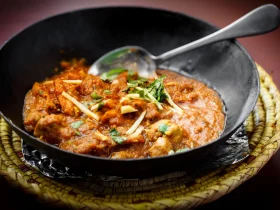

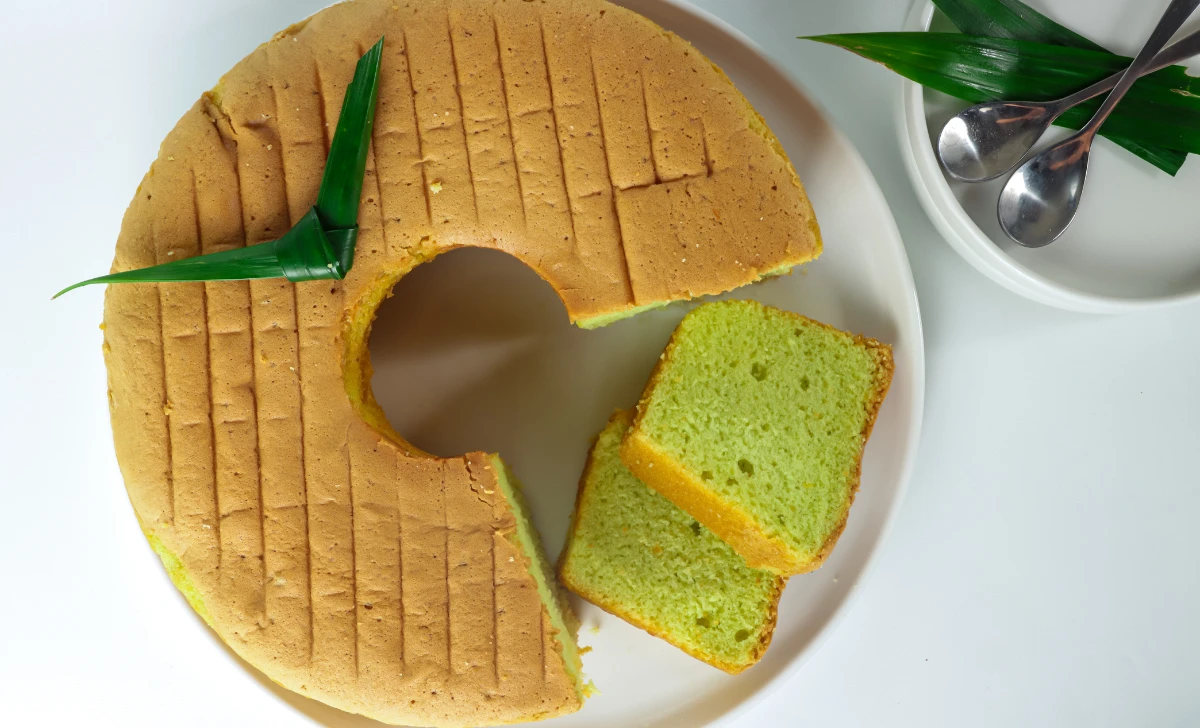

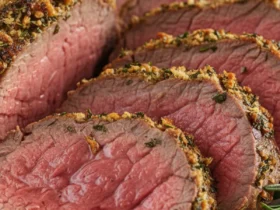
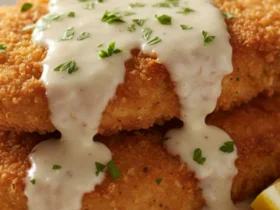
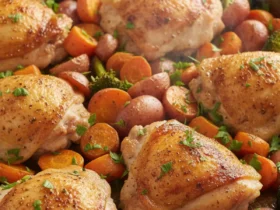
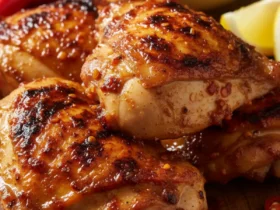
Leave a Review